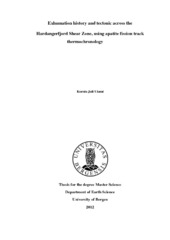Exhumation history and tectonic across the Hardangerfjord Shear Zone, using apatite fission track thermochronology
Master thesis
Permanent lenke
https://hdl.handle.net/1956/5776Utgivelsesdato
2012-02-09Metadata
Vis full innførselSamlinger
- Department of Earth Science [1076]
Sammendrag
ABSTRACT The Hardangerfjord Shear Zone (HSZ) is a large scale, ductile low angle shear zone, with SW-NE trending and NW dipping direction in the Caledonian crust. This zone has been formed at about 408-402 Ma (Fossen, 1992, 2000). A set of brittle faults formed about ~367 Ma (Schärer, 1980), northeast of the Hardangerfjord area, known as the Lærdal-Gjende Fault. Offshore, a set of brittle faults with NE-SW orientation, known as the Ling depression, may be linked to the HSZ in southwest. The North Sea area has protracted several rifting events following the Caledonian Orogenic collapse. The successive rifting events are believed responsible to the reactivation of the HSZ. By applying apatite fission track analysis, the possible reactivation of the HSZ was tried to be unrevealed, which could be reflected by an offset of Apatite Fission Track (AFT) ages between the two blocks. Five thermal history models were also developed to unravel the thermal histories of the rocks in the study area. The AFT ages show a significant difference between the two blocks whereas the samples were taken from the hanging wall of the HSZ have AFT ages range from 146.2 ± 9.3 Ma - 227.4 ± 14.3 Ma, with a weighted mean age of 174 ± 12 Ma (Middle Jurassic). Meanwhile, from the footwall is obtained AFT ages range of 180 ± 8.4 -105.6 ± 7.9 Ma, and the weighted mean is 145 ± 16 Ma ( Late Jurassic - Early Cretaceous time). The thermal history models result that the two blocks was subjected to a reactivation at about 250-180 Ma. This Permian cooling rate is rather slow about 1.50-30C/Ma. The second cooling event initiated at early Jurassic time, and only reactivated the footwall of the HSZ. It was documented in sample BG-62 which describes cooling rate of 60C/Ma at 190-180 Ma and shows a steep gradient. Both the cooling events occurred coincided to the Permian and Jurassic rifting in the North Sea. The area then experienced the burial event at the Middle Jurassic-Middle Cretaceous coincided with a period of transgression at Middle-Late Cretaceous (Doré, 1992; Riis, 1996). It is predicted from the cooling rate that the cooling event in the area occurred due to tectonic and erosional process.
